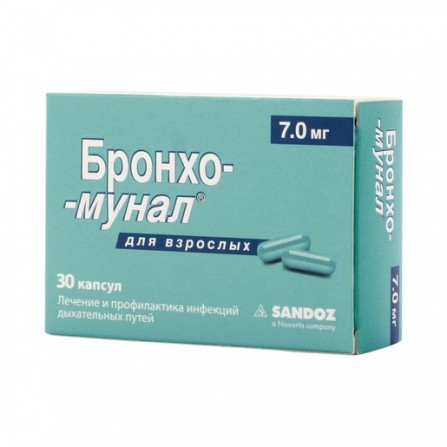Broncho-munal capsules 30 pcs
Condition: New product
1000 Items
Rating:
Be the first to write a review!

More info
Active ingredients
Bacteria Lysates [Hemophilus influenzae + Streptococcus pneumoniae + Streptococcus viridans + Streptococcus pyogenes + Klebsiella pneumoniae + Klebsie
Release form
Capsules
Composition
1 capsule contains: standardized lyophilisate of bacterial lysates (OM-85) 40 mg, incl. Lyophilized lysates of bacteria: Haemophilus influenzae, Streptococcus pneumoniae, Streptococcus viridans, Streptococcus pyogenes, Klebsiella pneumoniae, Klebsiella ozaenae, Staphylococcus aureus, Moraxella catarrhalis 7 mg. Excipients: propyl gallate (anhydrous) - 0.084 mg, sodium glutamate (anhydrous) - 3.03 mg, mannitol - up to 40 mg; magnesium stearate - 3 mg, pregelatinized starch - 110 mg, mannitol - up to 200 mg.
Pharmacological effect
Immunomodulatory drug of bacterial origin. It has an immunostimulating effect, enhancing immunity against respiratory tract infections. After taking a capsule, the bacterial lysate accumulates in Peyer's patches of the gastrointestinal mucosa, in particular, located in the small intestine. Antigen-presenting cells in Peyer's patches are activated by a bacterial lysate and subsequently stimulate other types of cells (B lymphocytes) responsible for specific immunity. The number of circulating B-lymphocytes increases, which leads to an increase in the production of polyclonal antibodies, especially serum IgG and IgA, secreted by the mucous membrane of the respiratory tract and salivary glands. The drug stimulates most leukocytes, which is characterized by an increase in the number of myeloid and lymphoid cells, as well as a selective increase in expression receptors on the surface. In patients receiving the drug, the protective properties of the body against bacteria and viruses are enhanced. Clinically, the drug reduces the From acute respiratory infections, reduces the duration of their course, reduces the likelihood of exacerbations of chronic bronchitis, and also increases the body's resistance to infections of the respiratory system. This reduces the need for the use of other drugs, especially antibiotics.
Indications
Infectious diseases of the respiratory tract (as part of complex therapy as an immunomodulating agent) in children aged 6 months to 12 years (for 3.5 mg capsules); - infectious diseases of the respiratory tract (as part of complex therapy as an immunomodulating agent) in adults and children over the age of 12 years (for 7 mg capsules); - for the prevention of recurrent respiratory tract infections and exacerbations of chronic bronchitis.
Contraindications
Pregnancy; - lactation period; - children up to 6 months (for capsules 3.5 mg); - children up to 12 years (for capsules 7 mg); - increased individual sensitivity to the components of the drug.
Use during pregnancy and lactation
Animal studies have not revealed a negative impact on the course of pregnancy. The safety and efficacy of the drug during pregnancy and during breastfeeding have not been studied, therefore, the use of the drug during pregnancy and lactation is contraindicated.
Dosage and administration
Adults and children over 12 years old are prescribed Broncho-munal; at a dose of 7 mg; children aged 6 months to 12 years are prescribed Broncho-munal; P at a dose of 3.5 mg. The drug is taken in the morning on an empty stomach (30 minutes before a meal), 1 capsule / day. If a patient / child cannot swallow a capsule, it is recommended to open it, dissolve the contents of the capsule in a small amount of liquid (tea, milk or juice). To prevent infectious diseases of the respiratory tract and exacerbation of chronic bronchitis, the drug is used in three 10-day courses with 20-day intervals between them. As part of the complex treatment of acute infectious diseases of the respiratory tract, 1 capsule / day is applied until the symptoms of the disease disappear, but not less than 10 days. In the next 2 months, prophylactic use of the drug in 1 caps is possible. for 10 days with a 20-day interval between courses.
Side effects
The drug is usually well tolerated. Most of the adverse reactions are classified as moderate to moderately severe. The most frequent manifestation of side effects is gastrointestinal upset, skin reactions and disorders of the respiratory organs. According to WHO, undesirable effects are classified according to the frequency of development as follows: very often (≥1 / 10); often (≥1 / 100, <1/10); infrequently (≥1 / 1000, <1/100); rarely (≥1 / 10,000, <1/1000); very rarely (<1/10 000); the frequency is unknown (the frequency of occurrence of the phenomena cannot be determined on the basis of the available data). On the part of the digestive system: often - diarrhea, abdominal pain; frequency is unknown - nausea, vomiting. On the part of the respiratory system: often - cough; infrequently - shortness of breath. On the side of the skin and subcutaneous tissues: often - rash. Allergic reactions: infrequently - hypersensitivity reactions (erythematous rash,generalized rash, erythema, swelling, swelling of the eyelids, swelling of the face, peripheral edema, swelling, swelling of the face, itching, generalized itching); frequency unknown - urticaria, angioedema. From the nervous system: frequency unknown - headache. General disorders: frequency unknown - fever, fatigue.
Overdose
There are no reports of intoxication due to overdose of the drug. The composition of the drug and the results of the study of its toxicity in animals indicate that overdose is unlikely.
Interaction with other drugs
The interaction of the drug with other drugs is not marked. The drug can be used simultaneously with other drugs, including antibiotics.
special instructions
Possible manifestations of hypersensitivity reactions to the drug. In case of persistent gastrointestinal disorders, skin reactions, respiratory disorders or other symptoms of intolerance of the drug, the patient must stop using the drug and consult a doctor. Use in pediatricsWill avoid overdose for children from 6 months up to 12 years should not appoint Broncho-munal; 7 mg, intended for adults. Influence on ability to drive motor vehicles and control mechanisms The drug does not affect the ability to concentrate and control vehicles and mechanisms.




